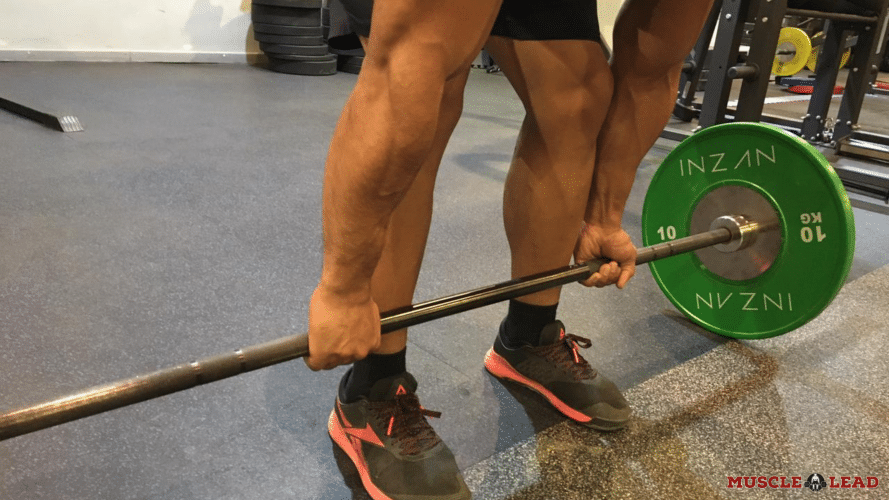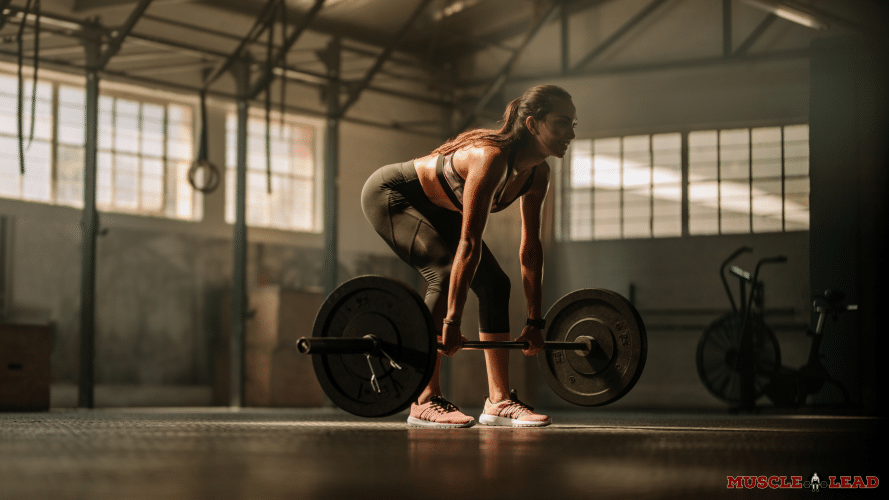The stiff leg deadlift is an EPIC strength training exercise. In my personal experience, within ~4 months of using it, I noticed some serious muscle gains and a 33% increase in strength.
The question is not “should you do them?” the question is “why would you not do them?” If you decide to use it, we can help you reap the benefits and avoid the common mistakes.
To do so we have discussed:
- “What Is the Stiff Leg Deadlift?”
- “Stiff Leg Deadlift vs. Conventional Deadlift”
- “3 Common Mistakes With The Stiff Leg Deadlift”
- “4 Stiff Leg Deadlift Benefits”
What Is the Stiff Leg Deadlift?
The stiff leg deadlift is a great variation of the conventional deadlift that we are all too familiar with. So it is a lower body exercise that works the back too.
Without giving away too much, it puts your body at a more disadvantaged position compared to the conventional deadlift (1).
Stiff Leg Deadlift vs. Conventional
So the main difference is in the knee joint movement. The conventional deadlift uses a knee flexion/extension and hits the quads (1).
The stiff leg deadlift takes this knee movement out of the equation by keeping the joint stiff. Essentially, this forces the hip extensor muscles to take the load. Pretty much Isolating the 3rd part of the deadlift (1).
In fact, the it actually takes more hip range. This is from tilting and stretching the hips further to grasp the bar. Basically compensating for not having the knee bend like the conventional deadlift (1).
Pulling from this position would put a lot more tension on the hip extensors (1).
Common Mistakes With the Stiff Leg Deadlift
There are 3 common mistakes that we see ALL the time. I kid you not, I could literally walk into any commercial gym and you pick out at least 1 being done in front of my eyes.
These common mistakes include:
- Bending At The Knees
- Lifting With The Bar Too Far Away From The Body
- Loading Too Much On The Bar
1. Bending at the Knees
As the name suggests, the whole point is to keep the knees stiff. Even a slight bend in the knees would bring the quadricep muscles into action.
This would take away from a lot of the tension that was supposed to go on the hip extensor muscles like the glutes and hamstrings.

To avoid this, simply keep your legs tense and knees stiff.
2. Lifting With the Bar Too Far Away from the Body
Starting with the bar too far away from the body messes the center of gravity up.
This makes the back curve forwards for leverage.
We are totally against any spine curving during any loaded exercise. It can cause spinal damage and have you out of action for a while.
Furthermore, the bar would have to travel through more range to get to the final position. This makes the lift way less energy efficient, so it may burn you out real quick. For this reason, you would not be able to maximize the stiff leg deadlift.
Words of advice, keep the bar close to shins while lifting.
3. Loading Too Much on the Bar
Many lifters think of the stiff leg deadlift like the normal one. So they tend to load up the same weights as their deadlifting working sets. The problem here is that it is actually designed to put your body in a disadvantaged position. It basically takes out the quadricep muscles and puts more effort on the glutes, hamstrings and lower back.
Without the extra strength generated through the quads, chances are that you would NOT be able to lift your normal deadlift loads.
So what happens if you use your normal deadlift loads? Well you either fail to lift it, or worse injure yourself from not being able to maintain form.
It is best to figure out your maximum intensity. From there, you can work in your desired intensity i.e. 75% intensity x 10 reps x 3 sets.
4 Stiff Leg Deadlift Benefits
There are 4 main benefits that it could yield during your fitness journey.
The benefits include:
- Muscle and Strength Gains
- Fix Muscle Imbalances and Lower Injury Risk
- Translates Into Conventional Deadlift
- Adds Variation To A Workout a Program
1. Muscle and Strength Gains
The muscles worked are mainly:
- Calves
- Hamstrings
- Glutes
- Lower back
- Lower lat
- Upper back
Using the stiff leg deadlift over the weeks and months, can reap some serious gym gains. The continuous breakdown and recovery of the stiff leg deadlift muscles, would likely make them larger and stronger.
Do Deadlifts Work Quads? (Yes, Here’s How)
The training benefit you want to prioritize will depend on the intensity and rep range you use.
Doing this deadlift at 65-75% intensity would put you in the ballpark of 8-15 reps. This would likely bring out more size gains from engaging the muscle building mechanisms (mechanical + metabolic stress).
Going really “heavy” ~80-100% would put you in a rep range of 1-5. This has the potential to build strength.
I usually suggest periodization to get the best of both. Remember how I put on muscle size and gained 33% in stiff leg deadlift strength?
Learn more about 20 Exercises to Improve Your Deadlift Strength
2. Fix Muscle Imbalances and Lower Injury Risk
If you have weak posterior muscles, the stiff leg deadlift can be put into your workout program to strengthen them. In turn, this can create more balance.
Not only would this make you look and feel better, but Lower injury risk. Let me tell you what I mean by that. Say you had strong quadriceps but weak hamstrings. This is very common and is known as a muscle imbalance.
The hamstring is the antagonist of the quadriceps. This means that it pulls the quads back and stops over stretching of their knee extension movement.

With a muscle imbalance like the one mentioned above, there is a risk of over stretching the lower leg and tearing the anterior cruciate ligament (ACL). The ACL is a knee stabilizer that joins the shin and thigh bone together.
Read more about Causes of Deadlift Shoulder Pain
3. Translates Into Conventional Deadlift
As we have mentioned, the stiff leg deadlift and the conventional one have some similarities.
Many lifters start off with a great conventional deadlift pull only to get stuck at the hip movement. Focusing on the stiff leg deadlift would allow you to isolate and bring out hip extension movement patterns.
This hip extension strength can then translate into conventional deadlift for you to hit the full ranges. I have coached dozens of lifters who have broken through >440 lb deadlift plateaus by reaping this benefit of the stiff leg deadlift.
4. Adds Variation to a Workout a Program
It is good to change things up with your workouts from time to time. Doing normal deadlifts all the time can get boring.
This kind of deadlift could keep your work out exciting so you can train with proper efforts. This may help maximize training benefits overall and not just for the stiff leg.
A Study by Rodrigo et al. (2) looked at the effects of changing exercises over a 12 week period on the modifications in muscle size and strength. The participants worked their lower bodies twice per week.
The participants that alternated on their leg exercises experienced the most muscle gains of 11.6% increase on the left leg and 12.2% on the right leg. Not to mention, the most muscle bound across all individual muscles of the leg. Alternating exercises also saw the biggest strength gains.
Final Thoughts
The stiff leg deadlift is a lower body exercise that also hits the muscles of the back.
The difference between the stiff leg and normal deadlift is that you do not use the knee levers. This takes the quads out of the picture and works the glutes, hamstrings, and lower back more.
Common mistakes are easy to avoid by considering the cues and figuring out your lifting abilities.
The benefits that the stiff leg could yield include; muscle/strength gains, fixing muscular imbalances, and making your normal deadlift stronger.
Frequently Asked Questions
Better for glutes, hamstrings and lower back, but not quads and overall strength.
Personally, no! I think there’s better exercises for strength based training like the Romanian deadlift. I use stiff leg for high reps and warm ups.
Definitely normal deadlift! It works all of the leg muscles.
References
- Beverra, E., Simao, R., Fleck, S.J., et al. “Electromyographic Activity of Lower Body Muscles during the Deadlift and Stiff-Legged Deadlift” Journal Of Exercise Physiology. 2013; 16 (1097–9751): 30-39
- Rodrigo, F., Hamilton, R., Valmor, T., et al. ‘Changes in Exercises Are More Effective Than in Loading Schemes to Improve Muscle Strength’ Journal of Strength & Conditioning Research. 2014; 28(11): 3086–3092
Read More
- Upper Back Pain While Deadlifting (5 Reasons And How To Fix)
- Deadlift Every Day: Pros, Cons, Programming (Science Based)
- 5 Great Benefits Of The Block Deadlift: Muscles Worked, How To Guide
- 8 Best Deadlift Accessory Exercises To Increase Strength
- How To Breathe During Deadlift – The Proper Way
- 10 Common Deadlift Injuries (+ How To Avoid Them)





